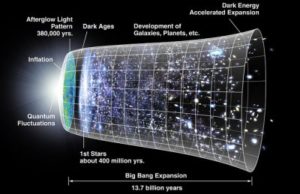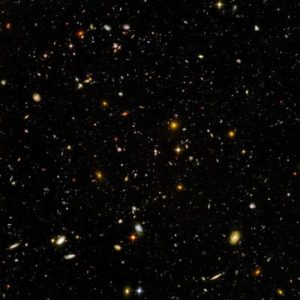Time and the Big Bang

The general view of physicists is that time started at a specific point about 13.8 billion years ago with the Big Bang, when the entire universe suddenly expanded out of an infinitely hot, infinitely dense singularity, a point where the laws of physics as we understand them simply break down. This can be considered the “birth” of the universe, and the beginning of time as we know it. Before the Big Bang, there just was no space or time, and you cannot go further back in time than the Big Bang, in much the same way as you cannot go any further north than the North Pole.
As theoretical physicist Stephen Hawking notes in his 1988 book A Brief History of Time, even if time did not begin with the Big Bang, and there was another time frame before it, no information is available to us from that earlier time-frame, and any events that occurred then would have no effect on our present time-frame. Any putative events from before the Big Bang can therefore be considered effectively meaningless (or at least the province of philosophical speculation, not physics).
Events after the Big Bang
The universe is expanding, and all the galaxies are moving further and further away from each other. In fact, we now know that this expansion is accelerating faster and faster (largely as a result of the mysterious dark energy that pervades the universe). If we were to play the movie of this expansion in reverse, we would see the universe become smaller and small as we go back in time, until ultimately the matter and energy of the whole universe is concentrated into a microscopic point some 13.8 billion years ago.
We can model this process remarkably closely (at least until the very early nanoseconds or less), and physicists have been able to piece together the major events in the evolution of universe, beginning with the tiniest fractions of a second after the Big Bang:
- Planck Epoch (the first 5.39 x 10-44 seconds after the Big Bang) – events (if any) occurring within this time must necessarily remain pure speculation.
- Grand Unification Epoch (10-43 to 10-36 seconds) – the force of gravity separates from the other fundamental forces, and the first elementary particles are created.
- Inflationary Epoch (10-36 to 10-32 seconds) – the universe undergoes an extremely rapid exponential expansion, known as cosmic inflation, and any existing particles become very thinly distributed.
- Electroweak Epoch (10-36 to 10-12 seconds) – the strong nuclear force separates from the other two forces (electromagnetism and gravity), and particle interactions create large numbers of exotic particles, including W and Z bosons and Higgs bosons.
- Quark Epoch (10-12 to 10-6 seconds) – the four fundamental forces assume their present forms, and quarks, electrons and neutrinos form in large numbers as the universe cools off to below 10 quadrillion degrees (although most quarks and antiquarks annihilate each other upon contact, a surplus of quarks survives, which will ultimately combine to form matter).
- Hadron Epoch (10-6 seconds to 1 second) – the universe cools to about a trillion degrees, allowing quarks to combine to form hadrons like protons and neutrons, and electrons colliding with protons fuse to form neutrons and give off massless neutrinos.
- Lepton Epoch (1 to 10 seconds) – most (but not all) hadrons and antihadrons annihilate each other, and leptons such as electrons and positrons dominate the mass of the universe.
- Nucleosynthesis (3 minutes to 20 minutes) – the temperature of the universe falls to about a billion degrees, so that atomic nuclei can begin to form as protons and neutrons fuse to form the nuclei of the simple elements of hydrogen, helium and lithium.
- Photon Epoch (10 seconds to about 240,000 years) – the universe is filled with plasma, a hot opaque soup of atomic nuclei and electrons, and the energy of the universe is dominated by photons, which continue to interact frequently with the charged protons, electrons and nuclei.
- Recombination/Decoupling (about 240,000 to 300,000 years) – the temperature of the universe falls to around 3,000 degrees, and ionized hydrogen and helium atoms capture electrons, neutralizing their electric charge and binding them within atoms; the universe finally becomes transparent to light, making this the earliest epoch potentially observable today.
- Dark Age or Era (about 300,000 to 150 million years) – the universe is literally dark, with no stars having formed to give off light; only very diffuse matter remains, and all activity tails off dramatically, with the universe dominated by mysterious “dark matter”.
- Reionization Epoch (about 150 million to about 1 billion years) – the first quasars form from gravitational collapse, and their intense radiation reionizes the surrounding universe, which goes from being neutral back to being composed of ionized plasma
- Star and Galaxy Formation (300 – 500 million years onwards) – small, dense clouds of cosmic gas start to collapse under their own gravity, until they trigger nuclear fusion reactions between hydrogen atoms and create the very first stars, which gradually cluster into galaxies.
- Solar System Formation (8.5 – 9 billion years after the Big Bang) – our Sun, a late-generation star incorporating the debris from generations of earlier stars, and the Solar System around it, form roughly 4.5 to 5 billion years ago.
The Ultimate Fate of the Universe

Our Sun is gradually getting larger, hotter and brighter, and the Earth will probably become uninhabitable within about a billion years from now. In about 5 billion years, our Sun is expected to turn into a red giant star, after which it will gradually shrink and cool into a small, dense white dwarf star, and ultimately into a dark, dead black dwarf star (in about 10 billion years from now). The rest of the universe, though, will continue its expansion and evolution.
There are several possible scenarios in physics for the ultimate fate of the universe, depending on the universe’s overall shape or geometry (i.e. whether it is flat, open or closed), on how much dark energy it contains (dark energy is an invisible, hypothetical form of energy with repulsive anti-gravity that permeates all of space, and that may explain recent observations that the universe appears to be expanding at an accelerating rate), and on the so-called “equation of state” (which essentially determines how the density of the dark energy responds to the expansion of the universe). Further advances in fundamental physics may be required before we can make predictions about the future of the universe with any level of certainty, but we can still look at the possibilities.
Without the repulsive effect of dark energy, the effects of gravity will eventually stop the expansion of the universe and it will start to contract until all the matter in the universe collapses to a final singularity, a mirror image of the Big Bang known as the “Big Crunch”. This also offers intriguing possibilities of an oscillating or cyclic universe, or “Big Bounce”, where the Big Crunch is succeeded by the Big Bang of a new universe, and so on, potentially ad infinitum, corresponding to a cyclic view of time.
If the acceleration of the expansion of the universe caused by dark energy increases without limit, one hypothesis is that the dark energy could eventually becoming so strong that it completely overwhelms the effects of the gravitational, electromagnetic and weak nuclear forces. This would result in galaxies, stars and eventually even atoms themselves being literally torn apart, sometimes referred to as the “Big Rip”, with the universe as we know it ending dramatically in an unusual kind of gravitational singularity within the relatively short time horizon of just 35 – 50 billion years. Time under this model would therefore be finite, rather than cyclic or infinite, in nature.
However, the most likely scenario, given our current knowledge of the constantly increasing effects of dark energy, is that the universe will continue expanding forever at an exponentially accelerating rate, ultimately turning space into an almost perfect vacuum as the remaining matter-energy becomes more and more diluted, a scenario sometimes referred to as “Heat Death” or the “Big Freeze“ or the “Big Chill”. Over a time scale of 1014 (a hundred trillion) years or more, the universe would reach a state of maximum entropy and thermal equilibrium at a temperature of very close to absolute zero, where it simply becomes too cold to sustain life or motion of any kind, and all that would remain are burned-out stars, cold dead planets and black holes. Eventually, after an almost unimaginable 10100 (a googol) years, even the black holes will have evaporated away, leaving nothing but random isolated particles floating in emptiness, with little or no prospect of ever interacting with other particles. The implication of this model is that, although time was finite in the past, it will be potentially infinite in the future, although in a scenario like this, where change is practically impossible, the very concept of time becomes effectively meaningless.
The problem with an infinite, eternal universe is that even the most unlikely events will eventually occur (and not only occur, but occur an infinite number of times). In such a scenario, every event would theoretically be equally likely to happen, which effectively undermines the basis for all probabilistic predictions of local experiments. A solution to this problem, according to physicist Raphael Bousso and his collaborators, is to conclude that time WILL eventually end, and he has set about calculating the probability of how and when time will end given five different cut-off measures. Two of these scenarios resulted in time having a 50% chance of ending within 3.7 billion years; in two other scenarios, time has a 50% chance of ending within 3.3 billion years; in the fifth (much less likely) scenario, the time scale is very short and time is overwhelmingly likely to end within the next second. In this hypothetical situation, the end of time is envisioned as similar to an outside observer’s description of a matter system falling into a black hole: everything would gradually slow down and eventually just stop.
Multiverse
An alternative model of the universe sees it as just one of a potentially infinite number of other parallel universes in an overall multiverse (a word actually coined as long ago as 1895 by the American philosopher and psychologist William James). Such a scenario is actually thrown up by many different physical theories, including quantum mechanics, string theory, brane theory, etc, and is increasingly being seen as a real possibility and as a solution to many of the inconsistencies and inexplicabilities in our current theories. It has also been proposed as an explanation for how our universe appears to be so fine-tuned for life as we know it, by calling on the anthropic principle (the idea that the universe is only as it is because we are here to observe this particular version of it).
Parallel universes may physically exist within the same dimensional space as our own universe, but beyond our cosmological horizon; they may exist within black holes; they may exist in other inaccessible dimensions; they may exist very close to our own, or even locked inside or superimposed on it in other dimensions. Some of these parallel universes may even have completely different physical constants and physical laws to ours. By definition, though, we can only ever experience our own universe, and just do not have – and never will have – the ability to see or interact with (or, for that matter, prove the existence of) the rest of the multiverse, and so it remains necessarily hypothetical.
This kind of universe of course also has implications for time, and it may be that what see perceive as time and the arrow of time is only a localized part of an overall concept of time.